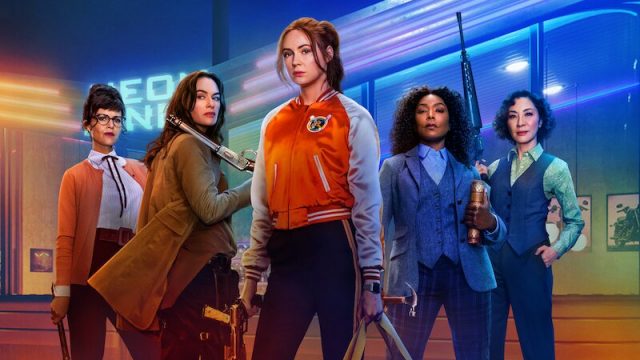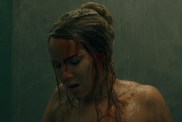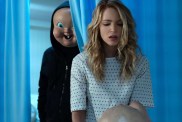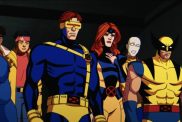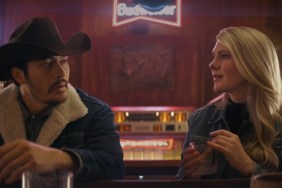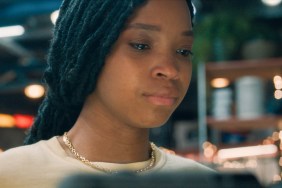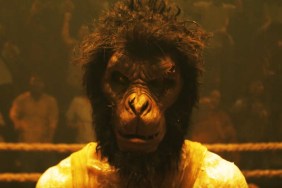With the deliciously violent Gunpowder Milkshake out on Netflix, ComingSoon’s Jeff Ames spoke to its renowned composer Frank Ilfman, who was kind enough to discuss his musical approach to Navot Papushado’s film.
Drawing inspiration from the legendary works of Bernard Hermann and Frebignch & Italian film noir scores from the 60s, Ilfman created a retro-noir vibe for the score, but still modern and grounded. It all began with a questions of how to take today’s electronic scoring sounds and put an orchestral spin on everything. Also, in keeping with the film’s theme of female empowerment, Ilfman used female musician soloists on much of the score – especially the action tracks, which have an element of 80s female rock band flair and were recorded with mostly female performers.
Ames: What drew you to the world of film and TV composing? I saw you studied at the renowned Jaffa Conservatorium of Music in Tel Aviv but didn’t take to the school’s structured methods.
Frank Ilfman: Yeah, I wasn’t quick on the boundaries and schooling of sorts. Even in normal school, out of 365 days out the year, I would go and do other things than study. We couldn’t afford a piano, so I studied trombone because I could get a free trombone, so I studied that for a couple of years and was in sort of a Dixieland Band. Then we purchased this really crappy organ, and then I transferred into playing keyboards and piano, and I had these old schoolteachers who would smack me on the hand with a ruler if I made mistakes. But somehow, I always came out with my own small tunes and melodies, so after a while, they just gave up on me and told me to go and do my own compositions.
So, I just kind of went in that direction. I was fairly fortunate throughout my teens to meet different composers like Earle Hagen and Klaus Doldinger and people like that who gave me direction and shaped me in that field.
Although that wasn’t my number one thing, I always wanted to be in a rock band. But, somehow, that led me into films.
How do you think TV and film music has changed since you entered the industry in the early 90s?
I think everything goes in a circle. When I first started, people were still doing films on film, and you didn’t have all the editing facilities you have today where you can cut from anywhere. It was all on film. I think music is a cycling thing where, even back then, we used orchestras, and you would use a rhythm section; and there were certain styles back in the 70s, 80s, 90s — and actually, they’re just a bit more modern today — but it’s the same feel. And today again, we’re kind of going back to retro stuff and synth stuff, and there’s more use of hybrid scores today, which are synth oriented. Whereas back in the 70s, it was more orchestral, and in the 80s, it was more synth-based, and then the 90s, it moved back to orchestral, and today we’re back to using synth styles.
Was that style one of the things that drew you to Gunpowder Milkshake?
Well, I had worked with Navot Papushado on a number of films, and we’re good friends outside of working hours. So, we have a very good rapport with how each of us works and how we communicate when we do a film. So, it was quite natural when he was doing Gunpowder that I would be attached. Especially with Gunpowder, and also with Big Bad Wolves, it’s kind of like a genre blender. So, as you say, you have a few styles – it’s a cross between film noir and a comic assassin book and a Western homage in some ways. So, we started playing from the start with musical ideas and playlists of how we see the score we want to do and pay homage to all of these old films and old scores. The idea was to, yeah, we might go retro, and we might do things that are very prestige in those periods, but we still wanted to make the score as modern as we could. So, it was very challenging, but that was the great part of being a part of Gunpowder was that it was such a challenge to try and combine all of these elements that Navot put in the film that I had to combine musically to create another character that would work with the film. So, when you hear the music, you can sort of picture gunpowder in your hand with all of these colors and visuals.
Absolutely, and there are a number of nods to Ennio Morricone and even some really heavy Latin American influence, particularly during the hospital fight scene.
Right, that was the Flamenco Mariachi Band. (Laughs)
What was the most thrilling sequence for you to work on?
Well, the bowling alley scene, which will be released as a single, we wanted to do almost like a — how would you do Ecstasy of Gold into a fight scene? For me, Ennio Morricone was not just an inspiration but almost like a mentor with the times we chatted. So, I wanted to pay quite a respectful homage to him. So, the question was, how do you take Ecstasy of Gold to some level and use those elements in a fight scene while keeping it emotional? So, that was quite fun to try and do and get the rock band to play with the orchestra and choir and everything. But, the doctor clinic one, which is the one with the Flamenco Mariachi band, that’s the one that was the most fun to do with all these crazy trumpets and vocals. We always wanted to have some humor in that fight because that fight is larger-than-life, and we had a cue that was an action cue that was also a little funny, but we felt we needed something crazier that was a little bit over the top. So, we thought, “Okay, what can we do in our film that can blend all of those elements,” and that’s where we decided to use the mariachi band, which worked great on the fight. That was the most fun cue to record.
So, with the sequel recently being announced, are there elements that you developed that you’re excited to reexplore?
When we were working on the film, it was almost throughout the year because we worked on a lot of it through the pandemic and recorded a lot of it through the pandemic, but the idea was that each of the characters should have a signature tune. So, McCallister has his own tune, and the firm has its own tune, and Sam has her tune, and there’s one that’s kind of the main theme of the movie, and then Scarlett has her own. So, each character has a signature sound and a theme, and they’re all in a way incorporated into one another. So, depending on which character continues into the sequel, we’ll just go from there. I have no idea where Navot is taking the sequel, so we’ll just have to wait and see.
